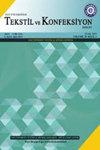一种用于从空气中收集水的亲水/疏水复合结构
IF 0.7
4区 工程技术
Q4 MATERIALS SCIENCE, TEXTILES
引用次数: 0
摘要
本研究的目的是通过使用由亲水区和疏水区组成的自然复合结构来改变传统金属丝网的表面,从而提高其从雾中收集水的能力。聚酰胺6 (PA6) /壳聚糖(CH)共混物通过静电纺丝或静电喷涂得到亲水性区,聚己内酯(PCL)的电喷涂得到类似的疏水性区。对所得网格的集水能力进行了测试和比较。PA6/CH纳米纤维包覆丝网的集水能力最高,为87 mg / cm2/h。与未涂覆的网相比,这种网能收集两倍的水。然而,当纳米纤维表面达到饱和水平时,其集水速率下降。在纳米纤维上加入疏水性PCL颗粒减少了水的捕获量。在这种情况下,网格的集水率继续增加。本文章由计算机程序翻译,如有差异,请以英文原文为准。
A HYDROPHILIC/HYDROPHOBIC COMPOSITE STRUCTURE FOR WATER HARVESTING FROM THE AIR
The purpose of this study is to improve the water harvesting capacity of the traditional wire mesh from the fog by modifying its surface using a nature-inspired composite structure consisting of hydrophilic and hydrophobic zones. Hydrophilic zones were obtained by electrospinning or electrospraying of the polyamide 6 (PA6) / chitosan (CH) blend, and similarly hydrophobic zones were attained by electrospraying of polycaprolactone (PCL). The water harvesting capacity of the resulting meshes was tested and compared with each other. The highest water harvesting capacity was achieved with the PA6/CH nanofiber coated wire mesh as 87 mg / cm2/h. This mesh collected twice as much water compared to the uncoated mesh. However, its water collection rate decreased when nanofiber surface reached the saturation level. The addition of hydrophobic PCL particles onto nanofibers reduced the amount of water captured. In this case, the water collection rate of the mesh continued to increase.
求助全文
通过发布文献求助,成功后即可免费获取论文全文。
去求助
来源期刊

Tekstil Ve Konfeksiyon
工程技术-材料科学:纺织
CiteScore
1.40
自引率
33.30%
发文量
41
审稿时长
>12 weeks
期刊介绍:
Tekstil ve Konfeksiyon, publishes papers on both fundamental and applied research in various branches of apparel and textile technology and allied areas such as production and properties of natural and synthetic fibers, yarns and fabrics, technical textiles, finishing applications, garment technology, analysis, testing, and quality control.
 求助内容:
求助内容: 应助结果提醒方式:
应助结果提醒方式:


